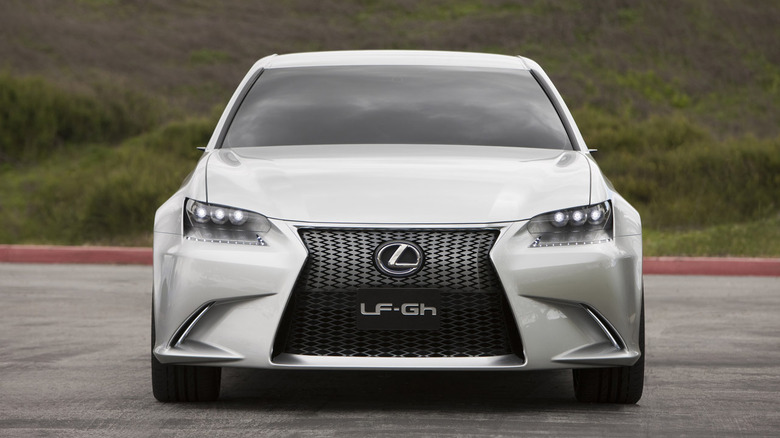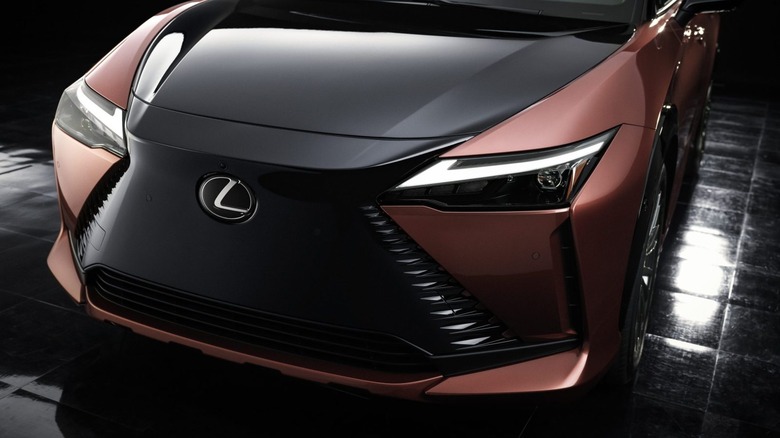Why Are Lexus Grilles So Big?
Many automotive manufacturers have carried a distinct brand image baked into their aesthetics for decades — BMW's twin grille, Dodge's cross-pattern, and the seven-slotted Jeep, to name a few. Lexus, however, didn't feature any such design choices; instead, it opted for more elegant, understated designs through the 1990s and 2000s, with many iconic 90s Lexus models among the best-looking vehicles in their class.
But then something changed around the early-mid-2010s; Lexus grilles suddenly grew wildly out of proportion. Often colloquially referred to as the "Darth Vader Grille," Lexus introduced the design language with the 2011 LF-Gh concept as an aggressive new fascia, following the modern trend of overly-angry looking front-ends. It's a trend that faces criticisms within the automotive community, and Lexus is no exception, admitting that the hourglass design wasn't particularly appealing in hindsight. But outside of its aesthetics, what was the point of having such a large, gaudy grille design?
The main purpose of grilles is to allow cool outside air to interact with the elements inside an engine bay, such as the radiator, intercooler, and air intake. And the Lexus grille is no exception here; many of its cars utilize either forced-induction or larger V8 powertrains, and the expansive grille allows for certain leeway when designing the layout of the engine bay. However, outside of that functional aspect, the grille was designed to emulate a hand loom, an homage to Toyota's early history as a textile company. As such, the grille design is known internally as the "spindle grille." Let's discuss more about its history, heyday, and the changes we're likely to see in the future.
Origins and usage of the Lexus spindle grille
Like many companies with a singular iconic visage, Lexus created the spindle grille design trend as a means of brand recognition. The original car to use its design, the LF-Gh (Lexus Future Grand-Touring Hybrid), debuted at the 2011 New York International Auto Show. Its development began in Lexus's Japanese design studio, overseen by general manager Kengo Matsumoto (the person responsible for the LFA's design). It aimed to capture a blend of artistry and functionality with a dramatic new styling direction. The grille was shaped to emulate a bold, assertive look that combined multiple elements into a single piece: namely, inlets for the engine bay, brake duct function, and aerodynamic performance.
This grille served as the template of most Lexus models beginning in 2012, with the release of the fourth-generation GS saloon and CT 200h, the grille has become an instantly recognizable hallmark of the brand ever since. The grille remained largely unaltered throughout the next decade, with the only significant design alterations between models being how the slats were oriented.
Some cars featured vertical contoured slats, others horizontal razor-blade-esque inserts like the LX, and performance-oriented cars like the RC F and LC with a honeycomb motif. The latter type looks especially appealing, according to journalists and fans, adorning particularly handsome models and often accented in the RC F's various racing liveries. In fact, many of the best-looking sports cars produced by Lexus feature the traditional spindle grille design.
Why Lexus is updating the design
Future Lexus sports cars, such as the upcoming GR Concept, do not use the signature spindle-shape grille template; rather, Lexus is redesigning the famous visage as part of a larger "spindle body." What this means is that a more traditional trapezoidal grille forms the bottom of the hourglass, while the upper portion (featuring the headlights and upper brow) tapers downwards, creating the hourglass's cap.
Lexus imagines this design as a seamless integration of the grille into the bodywork, accented by black inserts, a lower hood line, and redesigned front wing shape. The first car to utilize this new design direction is the RZ and RZ 450e, the latter an all-electric SUV with a distinct trapezoidal lower front fascia (blanked out like many electric car designs) and side vents.
This represents just one of many design changes occurring throughout the luxury industry, with another notable departure being the controversial, massive BMW grille, sometimes called a "pig-nose." However, in Lexus's case, the grille design marks a step in the right direction, with critics citing the older design as an eyesore, especially on larger vehicles like the crossovers and SUVs, with the most egregious being the current-model Lexus LX. Others cite the grille as working well on sportier cars, which use its aggressive proportions to their advantage, but not enough to swing the pendulum in the grille's favor.
This customer feedback led Lexus designers to go back to the drawing board, creating the new "spindle-body" look we're starting to see in upcoming and brand-new models. So, cherish the Darth Vader look while it lasts because it likely won't be for much longer.


